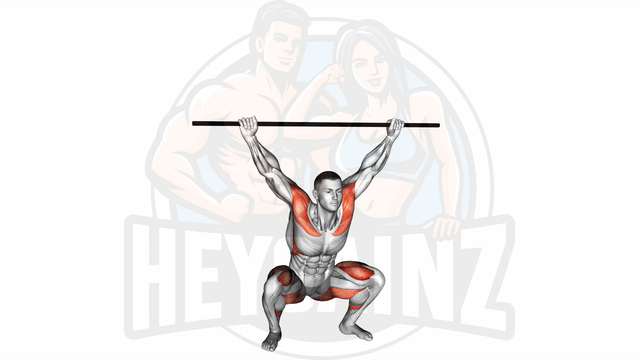
Instructions:
- 1Stand tall with feet shoulder-width apart while holding the PVC pipe overhead, with your hands just wider than shoulder-width apart.
- 2Begin by pushing your hips back, bending your knees, and lowering your body towards the ground keeping your chest up.
- 3Ensure your heels remain grounded and your knees track in line with your toes.
- 4Continue to lower until your hip joint is level with or below your knee joint.
- 5Extend your knees and hips to return to the standing position, keeping the PVC pipe overhead throughout the move.
Tips:
- Keep your back straight, chest up, and eyes facing forward to maintain proper form throughout the exercise.
- Ensure that your knees do not go past your toes when lowering.
- Move into the squat slowly to ensure control, and prevent injury.
- Make sure the PVC pipe is held in position overhead throughout the entire lift to engage the shoulder muscles properly.
PVC Overhead Squat: A Comprehensive Guide
The PVC overhead squat is an effective exercise that primarily targets the gluteus maximus and quadriceps, making it an excellent choice for individuals looking to enhance their lower body strength. This squat variation utilizes a lightweight stick, often a PVC pipe, allowing practitioners to focus on form and flexibility without the risk of heavy weights.
Benefits of the PVC Overhead Squat
The overhead squat offers numerous benefits. It improves overall strength, flexibility, and balance. Additionally, it engages multiple muscle groups, providing a full-body workout. With the PVC overhead squat, participants can refine their technique, which is crucial for mastering heavier squats in the future.
Is the Overhead Squat Dangerous?
When performed correctly, the PVC overhead squat is safe for most individuals and a great introductory exercise for those unsure about traditional squats. However, improper form can lead to injuries. It's essential to focus on maintaining a tight core and ensuring knees do not collapse inward during the movement. Make sure to gradually progress to heavier weights only when confident in your technique.
Is the Overhead Squat Good for You?
Absolutely! The overhead squat is beneficial for both seasoned athletes and beginners alike. It develops strength, stability, and mobility, making it particularly effective for anyone looking to enhance their fitness routine. Additionally, integrating this exercise can improve performance in other physical activities.
How to Set Up for Overhead Squat
- Start by standing with your feet shoulder-width apart.
- Hold a PVC pipe overhead with your arms fully extended, palms facing forward. Ensure your grip is slightly wider than shoulder-width.
- Engage your core and maintain a neutral spine as you begin the squat by pushing your hips back and bending your knees.
- Descend into the squat while keeping the pipe stable above your head, ensuring your chest stays lifted.
- Push through your heels to return to a standing position, maintaining control of the PVC pipe throughout the movement.
Tips for Mastering the PVC Overhead Squat
- Focus on your form; for beginners, practicing without any weight can help.
- Use a mirror to check your squatting position, ensuring the knees track over your toes.
- Warm up your body before performing this exercise, especially your shoulders, hips, and ankles.
- Consider incorporating mobility and flexibility exercises into your routine for improved performance.
Incorporating the PVC overhead squat into your workout regimen can lead to significant gains in strength and stability. Whether you're preparing for more advanced lifting or simply enhancing your physical fitness, this exercise is a fantastic addition to your routine. Remember, practice makes perfect, so take the time to refine your technique!